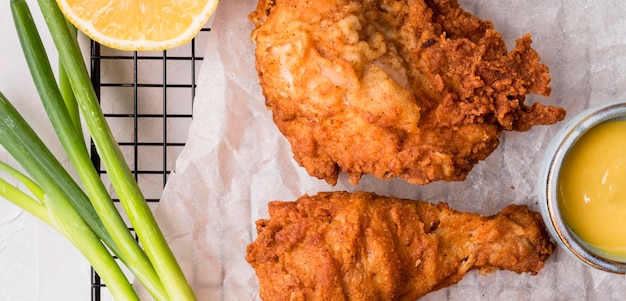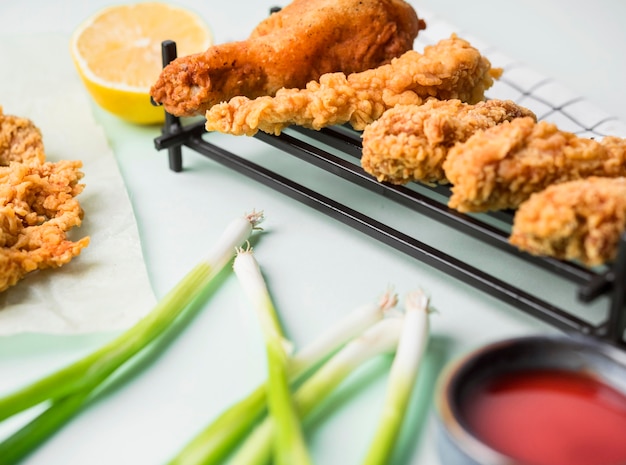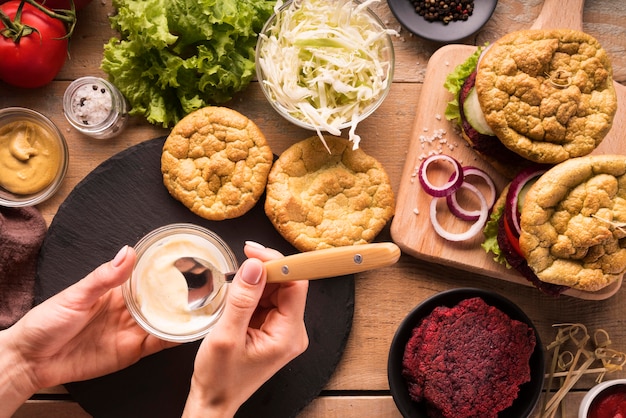1. The Right Chicken: It’s a Big Deal

1.1. Whole, Boneless, or Pieces: The Great Chicken Debate
Now, I'm not saying boneless, skinless chicken breasts are the enemy. They have their place, like in stir-fries or salads. But for frying? They tend to dry out quickly. And when it comes to fried chicken, juicy is the name of the game.
1.2. The Case for Whole Chicken
A whole chicken, however, is the true champion. It offers a symphony of textures and flavours, from the tender breast to the juicy thighs, succulent drumsticks, and even flavorful wings. It's a culinary masterpiece! Plus, a whole chicken is usually a better value for money.
2. Prepping the Chicken: Getting Ready for the Big Fry

2.1. Brining: A Secret Weapon for juicy chicken
This is a game changer, folks. Brining is all about soaking the chicken in a salt solution. It sounds simple, but it works wonders for moisture level and tenderness. You can make a basic brine at home by mixing salt, sugar, and water. But feel free to get creative with spices and herbs to add extra flavour.
2.2. The Brine Recipe: My Go-To Formula
Here's my tried-and-true brine recipe: 1 cup kosher salt 1/2 cup sugar 1 gallon water
Mix everything together, add your chicken, cover it, and let it chill in the fridge for 2-4 hours. Don't be tempted to skip this step! It makes a world of difference.
2.3. The dry rub: Adding Flavor from the Inside Out
After brining, I like to pat the chicken dry with paper towels and give it a good rub with my homemade spice blend. This adds another layer of flavour and helps create a beautiful golden-brown crust.
2.4. My Secret Weapon: The Dry Rub
My go-to dry rub is simple but effective: 1 tablespoon paprika 1 tablespoon garlic powder 1 tablespoon onion powder 1 tablespoon black pepper 1 teaspoon cayenne pepper (optional, for a bit of heat)
You can adjust the spices to your taste, but this is a great starting point.
3. The Big Reveal: Frying Technique

Now, we're getting to the heart of the matter – the frying! This is where you need to be focused and precise. The right technique is the difference between crispy, juicy fried chicken and a greasy mess.
3.1. The Choice: Cast Iron vs. deep fryer
There are two primary ways to fry chicken: in a cast iron skillet or a deep fryer. I've used both extensively, and each has its pros and cons.
3.2. Cast Iron: The Classic Way
cast iron skillets are a classic for a reason. They distribute heat evenly, creating a beautiful, crispy crust. However, you need to be careful not to overcrowd the pan. You need enough space for the chicken to cook evenly.
3.3. Deep Fryer: The Fast and Easy Option
Deep fryers offer a faster and easier way to fry chicken. They allow you to cook larger batches at once and ensure the chicken is submerged in hot oil for even cooking. However, they can be a bit more messy and require careful attention to temperature.
3.4. The Oil Choice: A Matter of Taste
The oil you choose is important too. I usually go with peanut oil because it has a high smoke point and a neutral flavour. But you can also use vegetable oil or canola oil.
3.5. The Temperature: The Secret to crispy chicken
Here's the key to crispy, juicy fried chicken: temperature! You need the oil to be hot enough to cook the chicken quickly without drying it out. I recommend using a thermometer and aiming for a temperature of 350 degrees fahrenheit (175 degrees Celsius).
3.6. The Frying Process: It’s a Dance
Once the oil is hot, carefully place the chicken in the fryer or skillet, making sure not to overcrowd. You want to give each piece enough space to cook evenly. Now, here comes the fun part: cooking time! It usually takes about 15-20 minutes for chicken pieces to fry to perfection. You can test for doneness by using a meat thermometer. It should read 165 degrees Fahrenheit (74 degrees Celsius) in the thickest part of the chicken.(Part 2) The Art of Mastering Fried Chicken Flavour
4. The Golden Rule: Mastering the Flavor Profile
You've got the perfect crispy, juicy fried chicken, but now it's time to take it to the next level with flavour. This is where you can let your creativity shine. There's a whole world of sauces, seasonings, and toppings to explore.
5. The Saucy Situation: Exploring Flavorful Dips
Let's talk about sauces! This is where things get really fun. A great sauce can elevate your fried chicken to another level.
5.1. The Classic: Honey Mustard
You can never go wrong with honey mustard. It's sweet, tangy, and a perfect complement to the crispy chicken.
5.2. The Spicy Kick: Hot Sauce
For those who love a little heat, hot sauce is a must-have. There are so many varieties to choose from, so find your favourite and let those spicy flavours burst on your taste buds.
5.3. The Tangy Twist: Ranch Dressing
Ranch dressing is a surprisingly good pairing with fried chicken. It provides a creamy, tangy counterpoint to the crispy texture.
6. The Secret Weapon: Seasoning Your Fried Chicken
Now, let's talk about seasoning. A good seasoning can make all the difference in the world. I've tried all sorts of combos over the years, but here are a few of my favorites:
6.1. Classic Cajun Spice
For a bit of spice and warmth, Cajun seasoning is a great option. It's typically made with a blend of paprika, garlic powder, onion powder, cayenne pepper, thyme, oregano, and black pepper.
6.2. The Sweet and Savory Mix
For a sweet and savory blend, try combining paprika, garlic powder, onion powder, brown sugar, and a touch of cayenne pepper.
7. The Finishing Touch: Toppings and Garnishes
No fried chicken is complete without a few finishing touches.
7.1. The Crunchy Crunch: Toasted Sesame Seeds
Toasted sesame seeds add a delightful crunch and a nutty flavour. They're the perfect finishing touch for a classic fried chicken experience.
7.2. The Green Factor: Fresh Herbs
Fresh herbs like parsley, cilantro, or chives add a burst of freshness and a vibrant green colour to your plate.
7.3. The Tangy Twist: Lemon Wedges
Lemon wedges add a bright, tangy flavour that cuts through the richness of the chicken.
8. The Sidekick: Perfecting Your Fried Chicken Accompaniments
No fried chicken feast is complete without the perfect sides.
8.1. The Classic Combo: mashed potatoes and Gravy
Mashed potatoes and gravy are a classic pairing for fried chicken. They're creamy, comforting, and a perfect complement to the crispy chicken.
8.2. The Southern Staple: Coleslaw
Coleslaw is a refreshing and crunchy side that balances the richness of the fried chicken.
8.3. The Healthy Choice: Green Salad
For a healthier option, a green salad is a great choice. It provides a fresh and vibrant contrast to the fried chicken.(Part 3) Fried chicken faqs: Answering Your Burning Questions
9. FAQs: Answering Your Burning Questions
Now, I'm sure you've got some questions about fried chicken. So, let's dive into the FAQs:
9.1. How can I avoid greasy fried chicken?
This is a common concern, but it's easily solved. Make sure to pat the chicken dry before frying, and don't overcrowd the pan. Also, try to drain the chicken on paper towels after frying.
9.2. Can I reuse the same oil for frying?
You can reuse the oil, but not too many times. It'll start to break down and get smoky after a few uses. Keep an eye on the colour and smell of the oil. If it starts to look dark or smell off, it's time for a fresh batch.
9.3. What should I do if my chicken isn’t crispy enough?
This can happen if the oil isn't hot enough or if you overcrowd the pan. If your chicken isn't crispy enough, you can try frying it for a few more minutes. But be careful not to overcook it.
9.4. How do I store leftover fried chicken?
Let the chicken cool completely, then store it in an airtight container in the fridge for up to 3 days. You can also freeze it for up to 2 months.
9.5. Can I make fried chicken ahead of time?
Absolutely! You can prep the chicken, brine it, and even fry it ahead of time. Just let it cool completely and store it in the fridge. Then, reheat it in the oven or in a skillet on the stovetop before serving.(Part 4) Fried Chicken Around the World: A Global culinary adventure
10. A Global Feast: Exploring Fried Chicken Variations
Fried chicken isn't just a Southern staple; it's a global phenomenon. Let's embark on a culinary journey and explore some fascinating variations from around the world.
10.1. Korean Fried Chicken: A Spicy Delight
Korean fried chicken is famous for its crispy texture and spicy, savory sauce. It’s often double-fried for extra crunch and then coated in a variety of sauces, including gochujang (Korean chili paste) and soy sauce.
10.2. Japanese Karaage: A Tender, Flavorful Treat
Japanese karaage is a popular street food that features bite-sized pieces of chicken marinated in soy sauce, ginger, garlic, and sake, and then deep-fried to perfection. It’s typically served with a side of lemon wedges and a dipping sauce.
10.3. Filipino Chicken Adobo: A Savory, Tangy Classic
Filipino chicken adobo is a dish that involves braising chicken in a mixture of soy sauce, vinegar, garlic, black peppercorns, and bay leaves. The braising process creates incredibly tender chicken with a deep, savory flavor.
11. Fried Chicken: A Culinary Masterpiece
There you have it, folks! The ultimate guide to crispy, juicy fried chicken. With all this information in hand, you’re ready to become a fried chicken master. Experiment with different techniques, flavours, and sauces, and don’t be afraid to get creative. Remember, the best fried chicken is the one you make with love and passion. Happy frying!(Part 5) Fried Chicken: A Culinary Journey Through Time
12. The History of Fried Chicken: From Humble Beginnings to Global Phenomenon
Fried chicken has a long and fascinating history. It’s a dish that’s evolved over centuries, blending traditions and cultures.
12.1. Ancient Roots: Frying’s Early Days
The art of frying food dates back to ancient civilizations. The Egyptians, Greeks, and Romans all employed various methods of frying, using animal fats and oils.
12.2. From Africa to America: A Culinary Exchange
Fried chicken’s journey to the United States can be traced back to West Africa. When enslaved Africans were brought to America, they brought their culinary traditions, including the practice of frying chicken.
12.3. Southern Roots: A culinary legacy
Fried chicken flourished in the Southern United States, becoming a staple in African American households. It was often served on special occasions, like holidays and Sunday dinners.
12.4. Fried Chicken’s Rise to Fame: A Cultural Icon
In the 20th century, fried chicken gained widespread popularity in the United States. It became a symbol of American cuisine, appearing in restaurants, fast food chains, and even on TV commercials.(Part 6) The Science Behind Crispy Fried Chicken: Unlocking the Secrets
13. The Science of Fried Chicken: Unveiling the Secrets of Crispiness and Juiciness
Fried chicken isn't just about taste; it’s also about science. There’s a fascinating interplay of chemistry, physics, and cooking techniques that create the perfect bite.
13.1. The Maillard Reaction: A Culinary Miracle
The Maillard reaction is a chemical process that occurs when sugars and amino acids in food react at high temperatures, producing a beautiful brown crust and a rich, complex flavour. This reaction is essential for achieving that golden-brown colour and flavorful crust.
13.2. The Role of Fat: A Lubricant for Flavor
Fat plays a crucial role in frying. It acts as a lubricant, preventing the chicken from sticking to the pan or the fryer basket. It also helps transfer heat evenly, ensuring the chicken cooks through without burning.
13.3. The Importance of Temperature: A Crucial Factor
Temperature is critical in frying. Too low of a temperature will result in greasy chicken, while too high of a temperature will lead to burnt chicken. The ideal temperature for frying chicken is around 350 degrees Fahrenheit (175 degrees Celsius).
13.4. The Dynamics of Moisture: Balancing Juiciness and Crispiness
The moisture content of the chicken is another key factor. You want to find a balance between juiciness and crispiness. Brining helps to lock in moisture, preventing the chicken from drying out during frying.(Part 7) The Future of Fried Chicken: Trends and Innovations
14. The Future of Fried Chicken: New Flavors, Techniques, and More
Fried chicken continues to evolve, with chefs and home cooks alike pushing the boundaries of flavour and technique. Let’s take a peek at the exciting trends and innovations that are shaping the future of this beloved dish.
14.1. Flavor Fusion: A World of Culinary Inspiration
Fried chicken is no longer confined to traditional Southern flavours. Chefs are embracing global inspiration, creating exciting combinations that blend spices, sauces, and cooking techniques from around the world.
14.2. Healthier Options: Striving for Balance
With a growing emphasis on healthy eating, chefs are exploring ways to make fried chicken healthier without sacrificing flavour. They’re using lighter batters, healthier oils, and techniques like air frying to reduce the calorie count.
14.3. The Rise of Plant-Based Fried Chicken: A Meatless Revolution
Plant-based eating is gaining momentum, and fried chicken is no exception. Chefs are creating innovative plant-based chicken alternatives, using ingredients like jackfruit, seitan, and tempeh to achieve that iconic fried chicken texture and flavour.(Part 8) The Ultimate Fried Chicken Experience: A Culinary Celebration
15. The Art of Serving Fried Chicken: A Celebration of Flavor
Serving fried chicken isn’t just about putting food on the table. It’s about creating a special experience, a culinary celebration that brings people together.
15.1. The Setting: Creating an Inviting Atmosphere
Set the stage for a memorable fried chicken feast with a welcoming atmosphere. Think rustic farmhouse tables, colorful tablecloths, and charming vintage decor.
15.2. The Presentation: A Feast for the Eyes
Don’t underestimate the power of presentation. Arrange the fried chicken artfully on a platter, showcasing the golden-brown crust and crispy texture.
15.3. The Company: Sharing with Loved Ones
Fried chicken is best enjoyed with loved ones. Gather friends and family around the table for a shared meal, laughter, and conversation.
15.4. The Memories: A Culinary Legacy
Fried chicken is more than just a dish; it’s a culinary legacy, a tradition passed down through generations. Share your love for fried chicken with your loved ones, creating memories that will last a lifetime.
And there you have it, folks! Your comprehensive guide to the ultimate crispy, juicy fried chicken. It’s more than a recipe; it’s a journey, a celebration, and a testament to the enduring power of food to bring people together. Now go forth and fry with confidence!Bonus:The Ultimate Fried Chicken Table:
| Category | Option | Pros | Cons |
|---|---|---|---|
| Chicken Type | Whole, bone-in, skin-on | Best flavour and texture | More time-consuming to prepare |
| Boneless, skinless breasts | Quick and easy to cook | May dry out easily | |
| Frying Method | Cast Iron Skillet | Even heat distribution, crispy crust | Limited batch size, requires more attention |
| Deep Fryer | Faster cooking, larger batches | Can be messy, requires careful temperature control | |
| Oil Choice | Peanut Oil | High smoke point, neutral flavour | Can be expensive |
| Vegetable Oil | Affordable, readily available | May impart a slight flavour | |
| Canola Oil | Healthy option, neutral flavour | May have a slightly lower smoke point |
Everyone is watching

Corn on the Cob: The Ultimate Guide to Perfectly Cooked Ears
Healthy MealsAh, corn on the cob. Just the name evokes images of sunny days, barbecues, and that sweet, juicy flavour that ...

Perfect Pork Roast Oven Cooking Time: A Guide to Delicious Results
Healthy MealsThere's something truly satisfying about a perfectly roasted pork. The aroma alone is enough to make your mout...

Ham Cooking Time: How Long to Bake, Smoke, or Boil a Delicious Ham
Healthy MealsAh, ham. It's a classic, isn't it? A real crowd-pleaser, especially around holidays. And when done right, it'...

Scallops: The Ultimate Guide to Perfect Cooking
Healthy MealsAh, scallops. Those delicate, sweet, and utterly delicious morsels of the sea. They hold a special place in my...

Spaghetti Squash: The Ultimate Guide to Cooking and Serving
Healthy MealsRemember that time you saw spaghetti squash at the supermarket, looking all bumpy and strange, and thought, "W...
